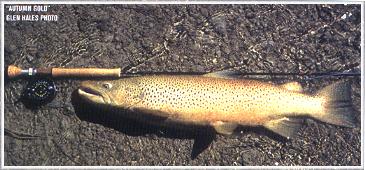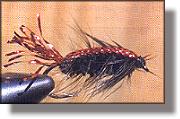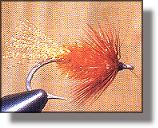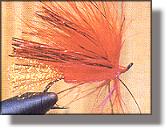Migratory Browns, part 3 (conclusion)
By Chris Marshall
From an Interview of Glen Hales, Associate Photo Editor,
The Canadian Fly Fisher
Presentation
Once you've spotted a brown (you'll be able to tell them from salmon,
because of their smaller size and thier greenish-yellow apprearance compared
with the blacker salmon) don't move any further. Take a few moments to plan
your approach. You'll need to get as close as you can without the fish spotting
you. Use whatever cover there is. If there is no cover, keep as far back from
the edge of the water as practicable, and kneel- crawl - if necessary. If you
keep downstream of the fish, you should be able to get quite close - often as
close as 10-15 feet. Sometimes you can get close enough so that you cast
is little more than a swing and a dangle.
Once you're in position, make your false casts away from the water (provided
there's room) and drop your fly far enough upstream of the fish so that it will
have sunk close to the bottom by the time it's drifted down to where the fish
is holding.

Try to keep the fly in sight as it drifts so that you can see if the fish takes it. If
it's impossible to see the fly, watch the fish - not the leader, the line or a strike
indicator. If the trout takes you'll see it move. this might be a minute movement
upstream, a sudden twist of the body, a turn of the head, or no more than an
opening of the gills and mouth. If you see any of these things when you see
any of these things when you think your fly is close to the fish, set the hook
Spmetimes, browns will take on the first drift, especially if you're using an egg
pattern for one which is actively feeding behind spawning chinook. However,
it is often necessary to tease with multiple drifts before you manage to induce a
strike. If this is the case, it's a good idea to rest the fish by pausing for five or
ten minutes after every half dozen casts.
Tackle
Migratory browns in the Great Lakes can run over twenty pounds,
but these are rare; most of the fish you'll locate will be between
five and twelve pounds. A six or seven weight outfit is the best. The
rod should be long, no shorter than 8 1/2' , preferably 9' or longers,
in order to provide optimum line control and distance from the
target fish. There's no need for disc-drag reel nor hundreds
of yeards of backing, as migratory browns seldom make long, blistering
runs. Rarely will they head for the lake as chinooks often do. The leader
should be short (5' - 6') toi facilitate short casts of under fifteen feet.
The only exception is when fishing places where the water is more than four
feet deep, and such places are uncommon on the small streams on Lake
Ontario's north shore. The ideal tippet size is 3X - 4X to accommodate
the relatively small flies which are used.
Flies
 Because migratory browns will feed in the stream, especially on chinook
spawn, flies which imitate natural food, such as egg flies and nymphs,
are essential. But for the times when trout are less inclined to feed,
attractor flies are needed. Because feeding takes place on or close
to the bottom, most patterns should be weighted, although shot
can be added to the leader to get the fly down.
Because migratory browns will feed in the stream, especially on chinook
spawn, flies which imitate natural food, such as egg flies and nymphs,
are essential. But for the times when trout are less inclined to feed,
attractor flies are needed. Because feeding takes place on or close
to the bottom, most patterns should be weighted, although shot
can be added to the leader to get the fly down.

Nymphs:
any impressionistic nymph in natural colors. Sizes #10 - #14.
 Egg Flies:
Egg Flies:
any of the conventional egg patterns, including impressionistic marabou-wing
streamers.

Attractors:
anything with sparkly and/or flourescent synthetics. The Xmas Tree in sizes
#8 and #10 nymph hooks is hard to beat. ~ Chris Marshall
 We thank the Canadian Fly Fisher for re-print permission!
We thank the Canadian Fly Fisher for re-print permission!
Our Man In Canada Archives
|



